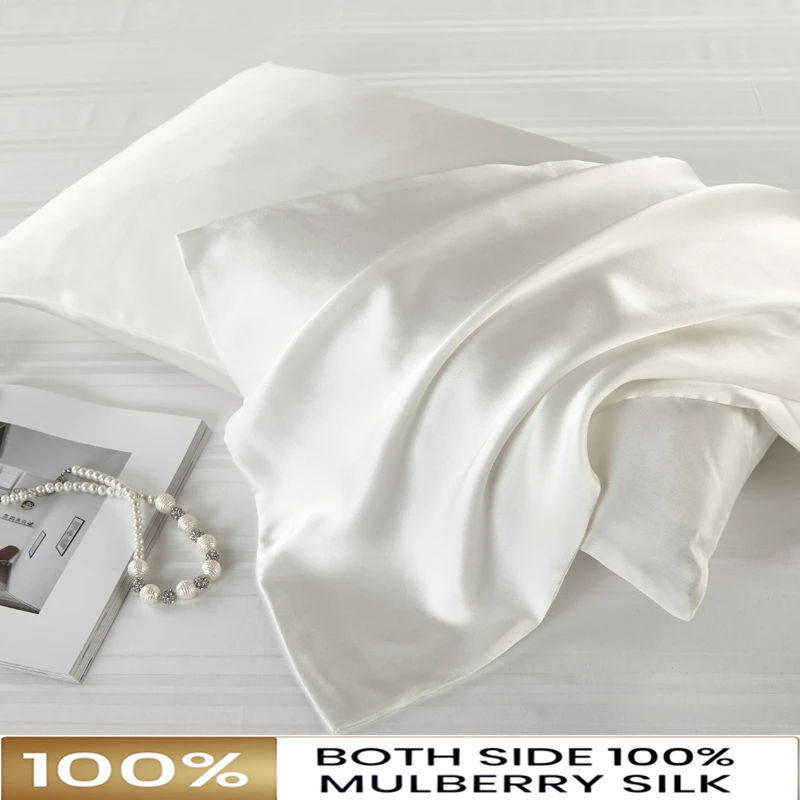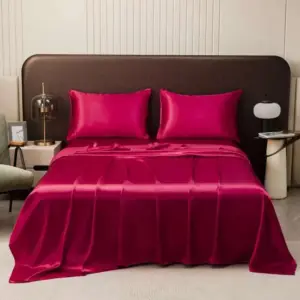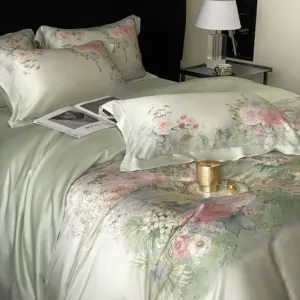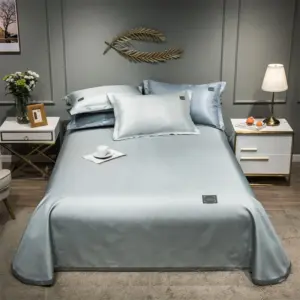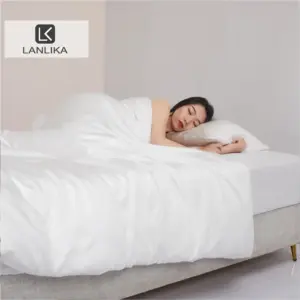Introduction
Silk stands as one of the world’s most luxurious textiles, admired for centuries for its smooth texture, beautiful luster, and comfortable feel against the skin. In today’s market, consumers face a choice between traditional natural silk and modern synthetic alternatives, each offering distinct characteristics and benefits.
Understanding the differences between natural and synthetic silk is crucial for making informed purchasing decisions, especially when investing in premium bedding or clothing. Whether you’re concerned about texture, durability, maintenance, or environmental impact, knowing what sets these materials apart will help you select the option that best meets your needs.
At Sanctuary Soft, we specialize in premium silk products and high-quality alternatives, giving us unique insight into the nuances of these materials. The amazing benefits of Mulberry silk sheets extend beyond simple luxury, but knowing how they compare to alternatives is essential.
This comprehensive guide will walk you through everything you need to know about both natural and synthetic silk, helping you identify authentic materials and choose the right option for your lifestyle, preferences, and values.
What is Natural Silk?
Natural silk is a protein fiber primarily produced by the larvae of certain insects, most notably the silkworm (Bombyx mori). The process of cultivating silkworms for silk production, known as sericulture, has remained largely unchanged for thousands of years.
Silkworms create cocoons from twin filaments of a protein called fibroin, held together by a gummy substance called sericin. When harvested and processed, these filaments create the exceptionally smooth, strong fiber we know as silk. Natural silk consists of approximately 97% protein and contains 18 amino acids beneficial to human skin.
What makes natural silk unique is its triangular prism-like structure that refracts incoming light, creating the material’s characteristic shimmering appearance. This structure also contributes to silk’s natural temperature-regulating properties and moisture-wicking capabilities.
The qualities that make Mulberry silk special include its exceptional smoothness, durability, and hypoallergenic properties that have made it prized throughout history as “the queen of fibers.”
Types of Natural Silk
Natural silk comes in several varieties, each with distinct characteristics:
Mulberry Silk: Produced by silkworms fed exclusively on mulberry leaves, this is the most common and highest quality silk available. Mulberry silk accounts for nearly 90% of global silk production and is characterized by perfectly white, uniform fibers that create an incredibly smooth texture. Premium Mulberry silk typically falls within the 19-25 momme weight range, offering the ideal balance between luxury feel and durability.
Tussah Silk: Also known as “wild silk,” Tussah comes from silkworms that feed on oak and juniper leaves. The resulting silk has a more textured feel, natural golden or light brown color, and is slightly less smooth than Mulberry silk.
Eri Silk: Sometimes called “peace silk” because it allows the silkworm to complete its lifecycle, Eri silk has a wool-like texture, is more durable than other varieties, but offers less shine.
Muga Silk: This rare silk from Assam, India, is known for its exceptional durability and distinctive golden glow that improves with washing and age.
Spider Silk: The rarest and strongest natural silk, spider silk is incredibly difficult to harvest at scale, making it primarily experimental rather than commercially available.
For those seeking the finest sleep experience, the complete guide to Mulberry silk bed sheets offers valuable insights into what makes this particular variety the premium choice for bedding.
What is Synthetic Silk?
Synthetic silk refers to man-made fibers designed to mimic the look, feel, and properties of natural silk. These materials were developed primarily to offer more affordable alternatives to natural silk and to meet growing global demand that sericulture alone couldn’t satisfy.
Unlike natural silk’s protein-based structure, synthetic silks are typically made from either cellulose (plant-based) fibers or petroleum-derived polymers. The manufacturing process generally involves dissolving these raw materials into a solution, then extruding them through tiny holes (spinnerets) to create filaments that are solidified, stretched, and treated to achieve silk-like properties.
The evolution of synthetic silk began in the late 19th century with the development of rayon, sometimes called “artificial silk,” and has progressed to include increasingly sophisticated materials that closely approximate various properties of natural silk.
Today’s synthetic silks range from basic polyester “silks” to advanced eco-friendly alternatives that offer compelling advantages for specific applications. The vegan silk vs natural silk comparison reveals how modern alternatives have advanced to provide options for those seeking silk’s benefits without using animal products.
Types of Synthetic Silk
The world of synthetic silk includes a diverse range of materials, each with unique properties and production methods:
Rayon/Viscose: The original synthetic silk, rayon is made from regenerated cellulose fibers, typically derived from wood pulp. It offers good drape and a silk-like sheen but lacks durability when wet and wrinkles easily.
Modal: An enhanced version of rayon, modal uses beech tree pulp and undergoes additional processing to improve strength. It offers better durability than standard rayon while maintaining softness and drape.
Lyocell/Tencel: A more environmentally friendly option, Lyocell uses a closed-loop production process that recycles nearly all chemicals. It offers excellent strength (even when wet), natural cooling properties, and sustainable credentials.
Polyester Silks: Petroleum-based synthetic fibers treated to resemble silk. These materials are typically the most affordable and durable options but lack the breathability and natural feel of genuine silk.
Nylon: Another petroleum-derived synthetic, nylon can be manufactured to closely mimic silk’s drape and sheen. It offers excellent durability but doesn’t breathe as well as natural or cellulose-based options.
Cupro: Created from cotton linter (the short fibers around cotton seeds), cupro offers an exceptionally silk-like drape and feel. It’s often used in high-end synthetic alternatives.
Advanced Silk Alternatives: Recent innovations include biodegradable synthetics made from sources like orange peels, milk protein, and bamboo cellulose, designed to better replicate silk’s beneficial properties while reducing environmental impact.
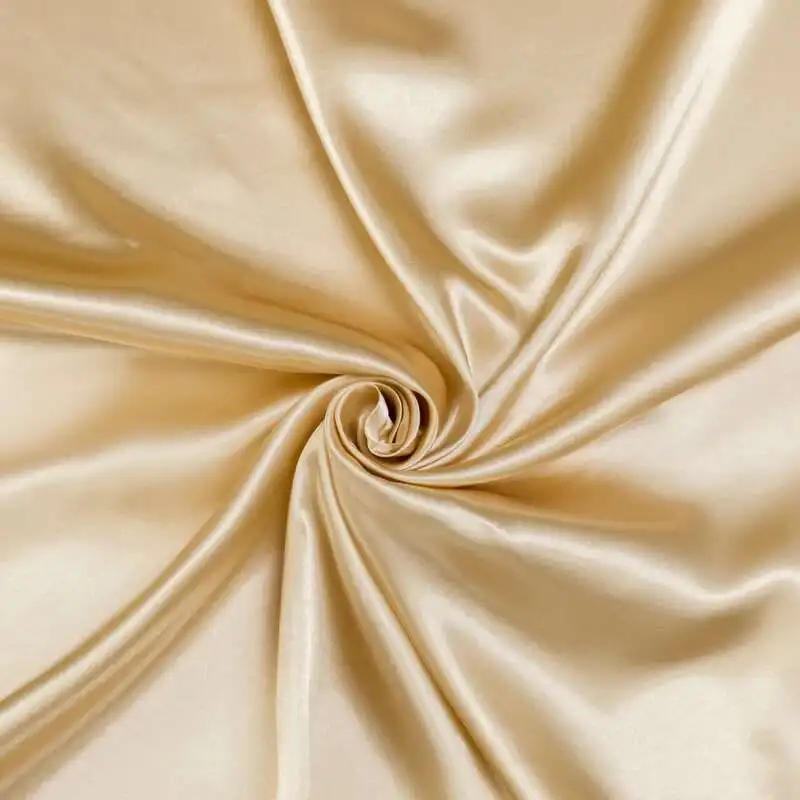
Our vegan silk bedding collection showcases how these synthetic alternatives can provide many desirable characteristics while meeting ethical considerations.
Material Composition: Natural vs. Synthetic
The fundamental differences between natural and synthetic silk begin at the molecular level:
| Characteristic | Natural Silk | Synthetic Silk |
|---|---|---|
| Base material | Protein (fibroin) | Cellulose or petroleum-based polymers |
| Structure | Triangular prism fibers with irregular surface | Cylindrical, uniform fibers |
| Fiber length | Long continuous fibrands | Variable depending on manufacturing |
| Protein content | ~97% with 18 amino acids | None (except protein-based innovations) |
| Molecular bonding | Natural hydrogen bonds | Chemical cross-linking |
Natural silk’s protein structure creates microscopic scales that give it unique properties. These irregular surfaces reflect light differently and allow the material to interact with skin in ways synthetic alternatives can’t fully replicate. The protein composition also explains many of silk’s beneficial properties for skin and hair.
Synthetic silks, by contrast, typically have smoother, more uniform fibers when viewed microscopically. This regularity affects how they drape, feel, and interact with light and moisture.
Understanding these composition differences is essential for measuring silk quality accurately and recognizing the inherent advantages and limitations of each material type.
Texture and Feel: The Tactile Experience
The tactile differences between natural and synthetic silk are often the most immediately noticeable:
Natural silk offers a unique combination of smoothness and subtle texture. It feels cool and crisp to the touch initially, then quickly warms to body temperature. Many describe genuine silk as having a distinctive “squeaky” feeling when rubbed between fingers. The material drapes fluidly and feels incredibly lightweight while maintaining substance.
Synthetic silks vary widely in texture. Polyester-based versions often feel slicker and slightly plastic-like compared to natural silk. Cellulose-based alternatives like modal and lyocell come closer to natural silk’s feel but typically lack its distinctive temperature-regulating properties. Many synthetics feel warmer than natural silk upon initial contact.
For sleep applications, these differences are particularly important. Natural silk creates minimal friction against skin and hair, reducing irritation and bedhead. It also absorbs and releases moisture without feeling damp, maintaining comfort throughout the night regardless of temperature fluctuations.
Our Mulberry silk sheets exemplify the premium tactile experience that quality natural silk provides, with a smooth, friction-free surface that enhances sleep quality.
Appearance and Luster: Visual Differences
Natural and synthetic silks interact with light in distinctly different ways, creating noticeable visual differences:
Natural silk displays a characteristic multi-dimensional shimmer often described as “pearlescent.” This occurs because the triangular fiber structure refracts light at different angles, creating a subtle glow that changes with movement. The surface has slight irregularities that give it depth and character rather than a uniform shine.
Synthetic silks typically exhibit a more consistent, uniform sheen. Polyester-based synthetics often have a more pronounced shine that can appear somewhat artificial in certain lighting. Higher-quality synthetics like cupro and lyocell achieve a more subdued luster closer to natural silk but still lack the complex light interaction of the natural material.
When draped, natural silk creates softer, rounder folds with a distinctive flow and movement. Synthetic alternatives vary in drape quality, with better versions approximating but not fully matching this characteristic.
For a direct comparison of visual quality and luster differences, our luxury silk bedding sets showcase the distinctive appearance that makes natural silk so prized.
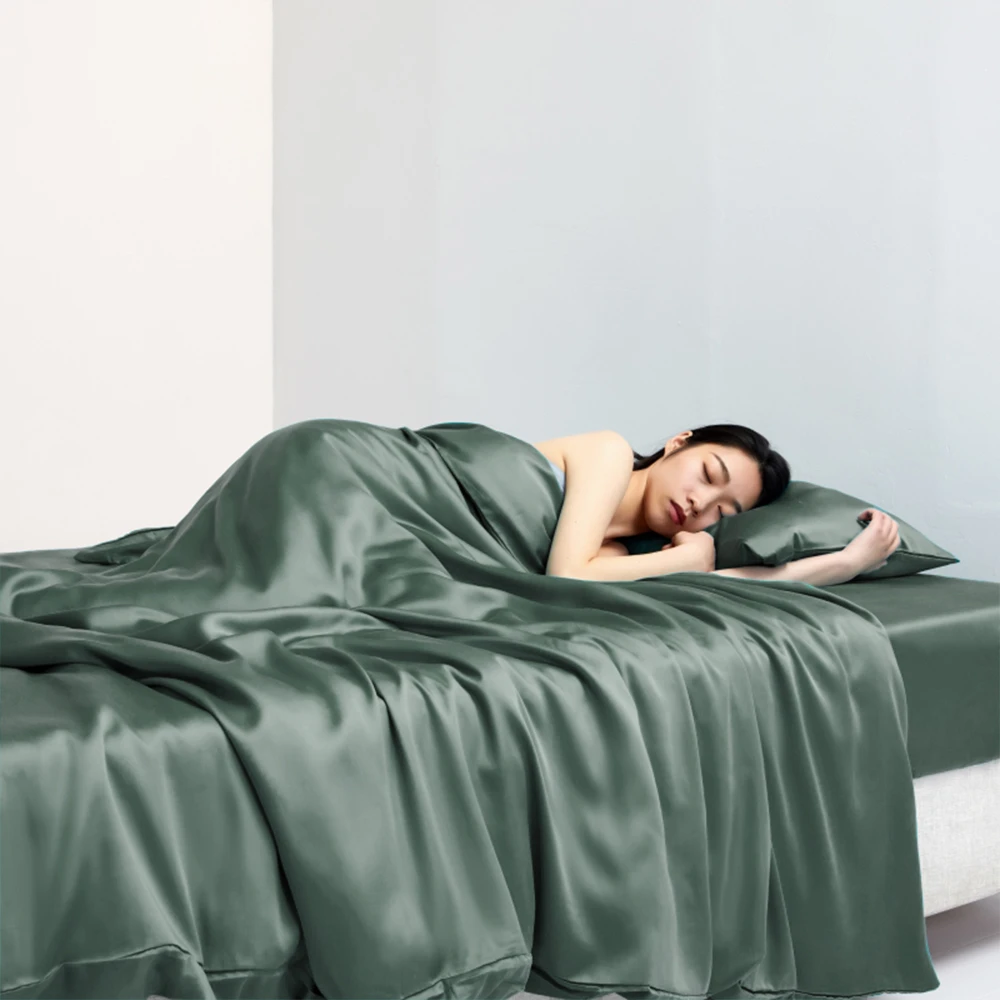
Durability and Longevity
Despite its delicate appearance, natural silk is surprisingly strong and resilient:
Natural silk has impressive tensile strength—comparable to steel of the same diameter—but is relatively brittle when dry. With proper care, high-quality natural silk items can last for decades, gradually softening with use while maintaining integrity. Its protein structure resists odor-causing bacteria and dust mites naturally, contributing to longevity.
Synthetic silks vary dramatically in durability. Polyester-based synthetics typically offer excellent resistance to wear but may pill over time. Rayon and viscose tend to weaken significantly when wet and may stretch or distort with repeated washing. Newer alternatives like lyocell offer improved durability compared to earlier cellulose-based synthetics.
Key durability differences include:
– Natural silk retains its beauty longer with proper care
– Synthetic alternatives may show wear patterns more quickly
– UV exposure damages both, but affects synthetics more visibly
– Natural silk is more vulnerable to prolonged moisture exposure
– High-quality synthetics may outlast poor-quality natural silk
The pros and cons of silk versus vegan silk include important durability considerations that can impact long-term satisfaction and value.
Breathability and Temperature Regulation
One of natural silk’s most prized qualities is its exceptional ability to regulate temperature:
Natural silk is highly breathable and serves as an effective thermal insulator—keeping you warm in cool conditions yet cool when temperatures rise. Its molecular structure allows it to wick moisture away from the body at an impressive rate, absorbing up to 30% of its weight in moisture without feeling damp. This combination makes it ideal for bedding that maintains comfort throughout seasonal changes.
Synthetic silks generally underperform in this area. Most petroleum-based synthetics like polyester trap heat and moisture against the skin. Cellulose-based alternatives perform better, with materials like lyocell offering reasonable moisture-wicking and breathability, though still not matching natural silk’s capabilities.
For those who sleep hot or experience night sweats, these differences can significantly impact sleep quality. Our cooling silk sheets highlight how natural silk’s temperature-regulating properties contribute to better sleep comfort throughout the year.
Health and Skin Benefits
The protein structure of natural silk offers unique advantages for skin and hair:
Natural silk contains 18 amino acids that mirror those found in human skin, creating a uniquely compatible surface for sensitive skin. The smooth fiber structure minimizes friction against skin and hair, reducing irritation, sleep creases, and bedhead. Its hypoallergenic properties make it suitable for those with allergies, eczema, and other skin sensitivities.
Synthetic alternatives generally lack these inherent protein benefits. However, high-quality cellulose-based synthetics like lyocell do offer some advantages—they’re typically hypoallergenic and create minimal friction. Petroleum-based synthetics like polyester are more likely to trap heat and moisture, potentially exacerbating skin issues for sensitive individuals.
For those with skin concerns, the Mulberry silk bedding skin benefits include reduced irritation, helping maintain skin hydration, and creating less friction against delicate facial skin during sleep.
Full-size Silk Sheets, King Size Silk Sheets, Queen Size Silk Sheets, Twin Size Silk Sheets, Washable Silk Sheets
Price range: $95.95 through $178.37 Select options This product has multiple variants. The options may be chosen on the product page100% Silk Sheets, Green Silk Sheets, King Size Silk Bedding Set, Mulberry Silk Bedding Sets, Queen Size Silk Bedding Set
Price range: $1,246.21 through $1,615.22 Select options This product has multiple variants. The options may be chosen on the product pageEucalyptus Silk Bedding Sets, Eucalyptus Silk Sheets
Price range: $360.24 through $393.60 Select options This product has multiple variants. The options may be chosen on the product page- Price range: $267.82 through $306.55 Select options This product has multiple variants. The options may be chosen on the product page
Bamboo Silk Sheets, Cooling Silk Sheets
Price range: $130.76 through $177.80 Select options This product has multiple variants. The options may be chosen on the product page100% Silk Sheets, King Size Silk Bedding Set, Mulberry Silk Bedding Sets, Queen Size Silk Bedding Set, White Silk Sheets
Price range: $1,000.79 through $1,351.42 Select options This product has multiple variants. The options may be chosen on the product page
Care and Maintenance
Care requirements differ significantly between natural and synthetic silks:
Natural Silk Care:
– Typically requires gentle hand washing in cool water with mild detergent
– Should be air-dried away from direct sunlight
– Needs ironing at low temperatures (silk setting)
– Should be stored carefully to avoid creasing and insect damage
– Professional cleaning recommended for structured garments
Synthetic Silk Care:
– Most can be machine washed on gentle cycles
– Many can be tumble dried on low heat
– Generally wrinkle less than natural silk
– More resistant to water stains and damage
– Typically easier for everyday maintenance
The care difference represents both an advantage and disadvantage for synthetics. While they’re generally easier to maintain, natural silk’s care requirements contribute to its longevity when properly followed. For those seeking easier maintenance without sacrificing quality, our washable silk sheets offer specially treated natural silk that can handle machine washing.

Environmental and Ethical Considerations
Both natural and synthetic silks present environmental and ethical considerations:
Natural silk production requires significant resources, including mulberry cultivation, silkworm rearing, and traditional harvesting that typically ends the silkworm’s lifecycle. However, silk is biodegradable, returning to the earth within 1-5 years when discarded. Production methods vary, with “peace silk” or “ahimsa silk” allowing moths to emerge before harvesting cocoons.
Synthetic silk production impacts vary widely by material:
– Petroleum-based synthetics like polyester contribute to fossil fuel consumption and release microplastics when washed
– Rayon production can involve harsh chemicals and significant water usage
– Newer alternatives like lyocell offer improved sustainability with closed-loop manufacturing systems
– Most synthetics take decades or centuries to biodegrade
For environmentally conscious consumers, exploring bamboo silk sheets and other sustainable alternatives provides options that balance performance, ethics, and ecological impact.
How to Identify Real Silk vs. Synthetic Silk
Several simple tests can help distinguish natural silk from synthetic alternatives:
The Burn Test:
1. Remove a small thread and burn it carefully with a lighter
2. Natural silk burns slowly, smells like burning hair, and leaves crushable black ash
3. Synthetics melt rather than burn and may form a hard bead
The Touch Test:
1. Run your hand over the fabric
2. Natural silk feels cool initially but quickly warms to body temperature
3. Natural silk creates a subtle “rustling” sound when rubbed together
The Ring Test:
1. Try pulling the fabric through a ring
2. Natural silk compresses easily and pulls through even small rings
3. Synthetics typically have more resistance and bulk
The Water Test:
1. Place a drop of water on the fabric
2. Water absorbs into natural silk, forming a temporary dark spot
3. Water tends to bead on synthetic alternatives
The Price Check:
Extremely low prices for “silk” products almost always indicate synthetic materials or very low-quality natural silk. Quality 100% silk sheets represent an investment but deliver unmatched benefits and longevity with proper care.
Which Silk Type is Right for Your Needs?
Choosing between natural and synthetic silk depends on several key factors:
Consider natural silk if:
– Quality and authentic luxury feel are your top priorities
– You value temperature regulation and breathability
– You have sensitive skin that benefits from silk’s amino acids
– You’re willing to follow proper care guidelines
– You’re making a long-term investment in bedding or clothing
Consider synthetic silk if:
– Budget constraints make natural silk prohibitive
– Easy care and maintenance are essential
– You need enhanced durability for specific uses
– Ethical concerns about traditional sericulture influence your choice
– Specific performance features match your particular needs
For bedding specifically, natural silk offers unparalleled benefits for skin health, temperature regulation, and sleep quality. Understanding why choose Mulberry silk sheets can help clarify the value proposition despite the higher initial investment.
Is Synthetic Silk Ever Better Than Natural Silk?
While natural silk excels in most quality measures, synthetic alternatives do offer advantages in specific scenarios:
Synthetic silks often provide superior durability for high-wear applications where regular washing is necessary. Their resistance to moisture damage makes them practical choices for certain clothing items and situations where exposure to liquids is likely.
Budget considerations also matter significantly. Quality synthetic alternatives can provide acceptable performance at a fraction of natural silk’s cost, making silk-like products accessible to more consumers.
Advanced synthetics like lyocell and modal have ecological advantages over both traditional silk and petroleum-based synthetics. These eucalyptus silk sheets and similar innovations offer compelling benefits for environmentally conscious consumers.
The ideal choice ultimately depends on your specific priorities, usage context, and individual values rather than an absolute quality hierarchy.
What Makes Premium Silk Worth the Investment?
Premium natural silk represents a significant investment, but delivers corresponding value:
The quality of natural silk is measured in momme weight (similar to thread count for cotton), with premium silks typically falling in the 19-25 momme range. This optimal range balances durability with the luxurious drape and feel that silk lovers prize.
Beyond momme weight, premium silk is distinguished by consistent fiber quality, careful processing to preserve the natural proteins, even dyeing, precise finishing, and meticulous construction. These factors contribute to both immediate sensory pleasure and long-term performance.
While the initial investment is higher, premium silk’s longevity often makes it more economical over time. Quality silk bedding can last for 10+ years with proper care, compared to 2-3 years for typical synthetic alternatives. This perspective makes choosing the right momme silk sheets an important economic consideration beyond the immediate luxury experience.
Common Myths About Silk: Fact vs. Fiction
Myth: Silk is too delicate for regular use.
Fact: Natural silk is surprisingly strong and durable when properly cared for, and can outlast many synthetics with appropriate maintenance.
Myth: All synthetic silks are environmentally harmful.
Fact: While petroleum-based synthetics raise environmental concerns, newer cellulose-based alternatives can have better ecological profiles than some traditionally produced natural silk.
Myth: You can easily identify real silk by burning it.
Fact: While the burn test is helpful, some advanced synthetics are engineered to mimic natural silk’s burning properties, making multiple verification methods necessary.
Myth: Silk bedding is only beneficial in warm weather.
Fact: Silk’s temperature-regulating properties make it suitable year-round, keeping you cool in summer and warm in winter.
Myth: All shiny, smooth fabrics marketed as “silky” contain silk.
Fact: Many products labeled “silky” contain no actual silk; always check fiber content labels for “100% silk” or specific synthetic fiber names.
Understanding these realities helps consumers make informed decisions based on facts rather than misconceptions or marketing claims.

